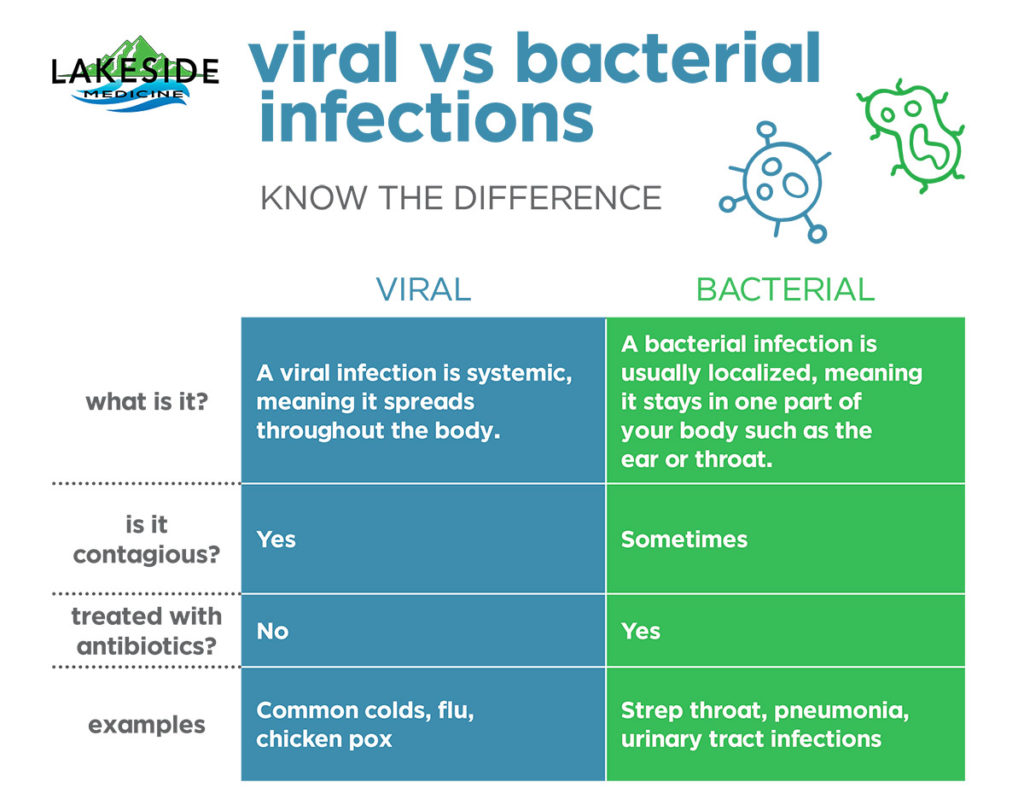In general, you can tell the difference by how long the patient is affected, the height of the fever, and the physical appearance of the patient. This can be tricky because both share similar symptoms. Viral infections can also turn bacterial. The only way to identify a bacterial infection for sure is a test from your physician, but there are some tell tale signs you can look out for.

Bacteria and viruses are both too small to be seen without a microscope, but if you could see them, you would find them to be just as different as elephants and spiders.
Bacteria are pretty complex for single-celled lifeforms. They are made up of a rigid wall and a thin, rubbery membrane surrounding the fluid inside the cell. They can replicate on their own. The fossil record indicates that bacteria have existed for about 3.5 billion years, and can live and thrive in many different environments, including but not limited to extreme heat and cold, radioactive waste, and of course, inside your body.
A lot of the bacteria found in your body are safe, and some help you out by absorbing disease-causing microorganisms, fighting cancer cells, and offering essential nutrients. Fewer than 1% of bacteria trigger illness in individuals.
Viruses are even tinier by comparison: the biggest of them are smaller than the smallest bacteria. All they have is a protein coat and a core of genetic material, either RNA or DNA. Unlike bacteria, viruses can’t live without a host. They can only multiply by attaching themselves to cells. They reprogram the cells to make brand-new infections until the cells burst and die. In other cases, they turn healthy cells into malignant ones that are cancerous.
Check out this video about how a virus attacks the body.
Unlike bacteria, most viral infections do trigger disease, and they’re quite particular about the cells they attack. Certain viruses attack cells in the liver, respiratory system, or blood. In some cases, viruses target bacteria.
Medical Diagnosis of Bacterial and Viral Infections
You need to consult your physician if you think you have a bacterial or viral infection with an exception for common colds, which are generally not life-threatening.
Numerous conditions including pneumonia, meningitis, and diarrhea can be triggered by either bacteria or viruses, which makes diagnosing the infection at home a challenge. Your physician often can determine the cause by examining your medical history and doing a physical examination.
To confirm suspicions, he or she can then draw a blood or urine test to assist or confirm. They can also use a “culture test” of tissue to determine whether it’s bacteria or virus. In some cases, a tissue biopsy may be required.
Tips for Identifying the Flu vs Bacterial Infection
If you have a sick kid with a runny nose, cough, sore throat and moderate fever. In order to get them feeling better as soon as possible, you have to correctly identify the source of the problem.
If it’s flu, or even worse, a bacterial infection such as pneumonia,
you want to act rapidly and appropriately without wasting time and money on the wrong treatment.
So what’s the difference?
Illnesses like influenza, or “the flu,” and upper respiratory infections (URIs) fall under the category of viral infections, while illnesses such as pneumonia, sinusitis and ear infections are bacterial infections.
Viral and bacterial infections often have comparable symptoms; however, your physician treats them differently. Perhaps the most important distinction between bacteria and viruses is that antibiotic drugs usually kill bacteria, but they aren’t effective against viruses.
Viral Infections
Viral infections can be identified by symptoms such as a runny nose, cough, small fever, sore throat and difficulty sleeping. The cold and URIs are the most common and stubborn of the viral infections. These types of infections can not be treated by antibiotics or anti-viral medications. Instead, you’re much better off simply living with it until the body immune system fights it off.
Influenza features many of the same characteristics as viral infections like URIs, in addition to body pains and a more severe fever. However, influenza can be treated using antiviral medicines, as long as the virus was detected within the first 48 hours. Depending upon the age of the patient, one or two flu vaccines throughout a given year can help them stay flu-free.
People with children should be aware that when it comes to URIs, children suffer from symptoms longer and develop URIs more often than grownups. Symptoms can last anywhere from 10 to 14 days, so make sure to watch out for enhancement during that timeframe.
One simple method to correctly identify if a viral infection is now bacterial is to keep track of symptom changes. If signs continue for more than 10-14 days and the fever is higher and is getting worse, the infection might have gone bacterial.
Bacterial Infections
Numerous bacterial infections are considered “secondary infections,” which implies the infection was viral, but due to exposure to bacteria, it ended up being a bacterial infection.
Here are a handful of common bacterial infections and what symptoms to watch for:
Sinus problems– a runny nose lasting longer than 10-14 days
Ear infection– Ear discomfort accompanied by brand-new start fever and several days of a runny nose
Pneumonia– a Consistent cough, stomach ache or problem breathing
Urinary tract infection– Fever without a quickly recognizable source of infection (more common in girls and young boys who are not circumcised).
Other symptoms to keep an eye out for if you think it may be a bacterial infection include dehydration, trouble when breathing, decreased energy levels or responsiveness, little to no improvement in 3-5 days.
What’s the Best Way To Be Sure…?
There are a variety of tests to help you precisely determine if you or your child has the flu or a bacterial infection. That’s why it’s imperative they get appropriately evaluated by a trained professional. Call Kelly Fuhrman, ARNP at Lakeside Medicine today for an easy appointment. (208) 290-3302


